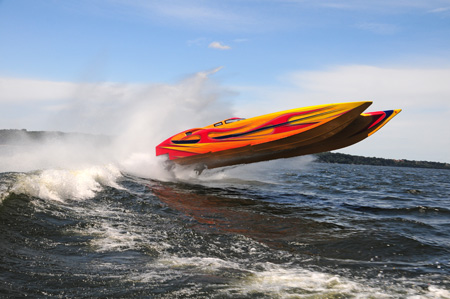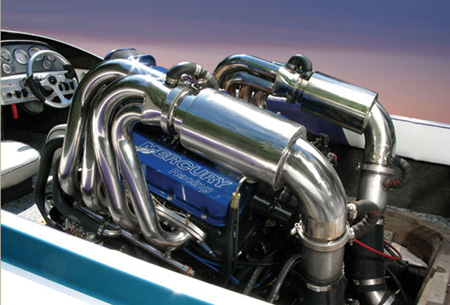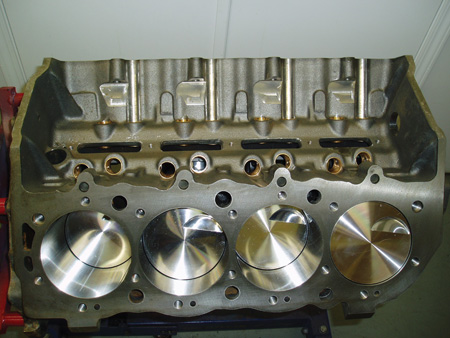It is said to be one of the last great open frontiers. Many experts say that it’s just about the last place on Earth where there are no rules to confine speed or size. It’s a place that has lured men with adventure and danger for centuries and now may be calling you, the engine builder.
The water – whether it’s the open ocean, protected inlets or inland lakes – allows your imagination to run wild and to dream up machines and engines no road could support. The only limits on the water are your customer’s bank account, and in offshore performance boating that limit seems pretty wide open as well. Small to midsize boats have taken a beating from the economy’s waves but experts say that high-end speed boats and race boats are still churning the waters in good numbers. Granted, building engines for these high performance vessels is no easy task, and engine builders who do it well say it is not for the faint of heart.
Bob Madea of Marine Kinetics in Rochester, NY, pins the popularity of the marine market on the fact that roads are too limiting today. “I bought my first car, a Z28 Camaro, in 1969. I’d proceed to get out on a country road and drive in ways that would get me thrown in jail for 10 years today. That frontier of the open road is really disappearing today. You can’t drive cars on the street anywhere near like was normal in the 1960s. Out on the water, however, it’s very much Dodge City today. It’s the Showdown at the OK Corral. There are no rule makers, no eye in the sky – it’s just you and the other guy. But that’s where it sometimes gets tricky. You’ve got boats now, some of the really big ones in particular, that go easily over 200 mph on the water.”
Peter Pavkovich of Custom Marine Sales in Fort Lauderdale, FL, says the majority of the market is still smaller boats but the high-end performance boats are big. “We do high-end or extreme high-performance boats between 38 and 50 feet. We build pleasure boats that will run 185 mph. Most everything we build now will run 100 mph. It’s rare if we do a boat that won’t run that fast in a performance boat.”
Shades of Miami Vice? “The 38 Cigarette was kind of a staple for us,” acknowledges Pavkovich. “We sold those boats over and over until about the the last year and a half. Lately, we’ve sold very few of these boats. Instead we have been selling more of the $700,000 to $1 million boats with bigger power. While I can’t say how it is for everyone else, that is how our business has been. We do a lot of specialty stuff. We’ll work with the manufacturers and manage part of the build or do part of it ourselves to take it to the next higher level of detail and customization.”
“Bigger is better” only goes so far on the automotive side, but it offers unique opportunities to the marine engine builder. “You can’t put two engines in your Chevelle, for example – it is basically defined for you. My favorite is the under 30 ft. segment of the market,” says Madera. “When I first into the marine market, Donzi had some nice 18s and 22s, as well as the Magnum series, which included a 26, 27 and 28 ft. Starfire. A 30 foot boat was a really big boat back in those days. And it was just one of those things that if 30 ft. was good, then 35 had to be better, and 40-45 was even better and so on. Because there are no dimensional considerations with boats, then triple 1,200 hp engines in a 42 ft. boat just made sense. Excess is good in the boating market.”
Engine needs depend on the size and type of boats they are used in, according to Pavkovich. “There are many two and three engine boats and even some four engine stuff. A lot of people call these boats Cigarette boats as if it were a generic name, but that is a brand of boat. They are Ocean racers or Offshore boats, which is what most people call them. We do sell some race boats, but high-performance pleasure boats is mostly what we sell.”
The typical marine engine in a pleasure boat might spend 10 percent of its time idling, maybe 60 percent of its running time at cruising speed (4,000 rpm), and maybe 10 to 30 percent of its time running at wide open throttle (5,500 to 6,500 rpm). A performance boat might spend 5 percent of its time idling, and 95 percent of its running time at wide open throttle at speeds as high as 200 mph at 8,000 rpm.
What’s happened in the last 10 years or so, according to experts, has been a triad of improvements: the materials have gotten stronger and lighter and the bottom designs of the boats have gotten a lot more efficient. So boats today are more efficient and light and the power has gotten so much better than they were not that long ago. Pavkovich says he no longer considers a 700 hp supercharged BBC that big a motor. It’s a motor he considers for long life and reliability. About 15 years ago these 700 hp engines had a much smaller lifespan, good for maybe 150-200 hours of use. Now these engines will last longer – if, of course, they are properly maintained.
Madera says he got started in the marine market by putting together cylinder head and camshaft induction packages for a group of people. «We made really good numbers with the package, and I started working with a select group of engine builders. I would put packages together and the engine builders would do the short blocks and we combined these packages. Today my customers are in 38 states, Australia, Sweden and Finland. The genesis of this came about through the Internet. I did some engine work and it came up on an offshore forum (such as seriousoffshore.com). People started calling and business eventually evolved to where I had a lot of consulting work and from there I went a little further with it.”
Madera says most of the work he does with marine engines is in the top end with cam selection and valvetrain work. “On pump gas we are more limited on compression ratios,” says Madera. “I have no problem running a tick over 11:1 on the street with pump gas if everything is set up correctly. But with the loads we pull with marine applications and the periods under full load, the area between peak torque and peak power if you get it wrong and you do detonate, chances are it ends your day pretty quickly. We deal within pretty strict parameters.”
Madera says he is constantly challenged with making these marine engines perform with 8.5 to 10.7 compression ratios. “Working with an 8.5 engine is a bear to make power and work correctly. If you’re running at 8.5 you’re usually running some sort of blower setup. You really have to shorten up your IDC (Intake Duration Curve) to make any kind of cylinder pressure at all. If you put too much duration into it, it’s just a pig.”
Another aspect that is unique to marine work is that it is the only motorsport in the world where water is intentionally injected into the exhaust manifolds. It is required by law that boats have water jacketed headers; otherwise the likelihood of engine compartment fires is huge. You get a glowing hot head in the engine compartment and it’s pretty much game over.
“Our challenge comes from the fact that you’re dumping water in the risers (collector),” says Madera, “which comes straight up off of the exhaust manifold, not down. You have a manifold on your cylinder head that comes up and takes a 90 degree turn and sweeps back through the transom (back of the boat). The water from the jackets is dumped from the collectors (risers) at a given point in there. What happens is, with any kind of a camshaft with any sort of overlap at all at idle you’re going to have a great deal of exhaust reversion. And these water droplets will start to work their way back. Instead of coming up, they head back down because the risers are pointed upward. It’s the opposite of an automobile engine.”
Drop water on a hot exhaust valve and it’s sideways in the port very quickly. “If you come off a 100 mph run and come down in the water, dropping back to 750 rpm in gear, and the water starts to revert back, at the 90 degree riser you have a straight shot back to the exhaust valve,” says Madera. “That poses a real challenge for intermediate performance boater, the guy who wants a good set of heads, a cam, a new intake manifold, a pro systems carburetor and then the exhaust manifold. The whole system has to be built around that.”
The guys who build these high-end marine performance engines are building at a top level of performance just like NHRA Pro Stock and NASCAR engines where there is a lot of engineering and technology going into it.
“It’s a whole different mindset,” says Madera, “To be able to get a 4.250? or 4.375? stroke and put together a valvetrain with 9-inch pushrods that spins at 7,600 rpms for 15 minutes at a time – it’s a delicate balance. For me, from a technical standpoint on all the development that I do, probably 90 percent of what I do is in the top end. On the airflow side, I know when to defer to someone to do my cylinder heads. I’ve had the good fortune to be able to work with Darin Morgan. Some guys say, ‘I can do this and that,’ but to me, Darin is the guru of airflow. He has 25,000 hours on a flowbench. So I’ll let him handle that part. My biggest focus is on the valvetrain. Keeping a stable valvetrain is the heart of the marine performance engine.”
Mark Rinda of MER Performance Marine says the marine market ranges all over from carbureted to EFI, supercharged and all sorts of different directions. He also believes the marine market overall is, in some areas, behind in comparison to Mercury Marine. “They have the latest and the greatest, but they also charge for it. Not everyone wants to pay for it. However, you can get a lot more bang for your buck if you go with a custom marine engine.”
Mercury runs a lot of different internals, including GM components, according to Rinda. “When you get into Mercury’s blue performance engines, such as the 525 EFI, it’s a GM forged crank with either Manley or Carrillo rods. Then they’ll throw a pressed pin in it and a set of JE pistons with (in the past) Crane rocker arms, hydraulic roller lifter and cam. I know that Edelbrock did a special casting for them that incorporates different water passages for their closed cooling system. It’s really just on the end, the end of the cylinder head has a boss that you can put a plug in it if it’s on the back, or if the head is on the front side there will be an O-ring groove and then three bolts that holds the heat exchanger on the front of the engine. That’s really the biggest difference, plus their EFI system that they call the triple nickel.”
For engine builders, says Rinda, the changes have been much more obvious in the past couple of years. “I can just look at my bank deposits to confirm that,” he jokes. “It’s not totally dead, but there are a lot of boats now on the market or that have gone back to the bank. We’re not building a lot of new stuff. People may be fixing what they have but they are not as free with their money as before. We’re not seeing as many people who want to build big, big power as before. Most just want to hold on to their boats and enjoy boating until things turn around. It’s like everyone is in a holding pattern and waiting for things to get better.”
Still, boats age and service is required. “Around here when the boat get to a certain age where the engine needs a rebuild, a lot of the guys take that opportunity to start boosting their power,” explains Rinda. “In some cases if they have a boat with a warranty, they won’t mess with the engine until the warranty is up. But I’ve also had customers who don’t care and want to customize their engines over stock right away. I had one customer who did this and took his engine to someone who messed it up so badly that I had to fix it for him. That was one of those $85,000 jobs.”
You can only go so far on the cubic inch builds, according to Rinda. “You can build pretty big engines but they have to last. The loads are higher, there’s no free time on a boat engine unless it’s sitting on the trailer. What we put on a boat race engine in one day you may not do on a car race engine in a year.” 















